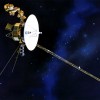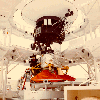
Artist concept of the two Voyager spacecraft as they approach interstellar space (Image credit: NASA/JPL)
The Voyager 1 spacecraft launched by NASA on September 5, 1977 continues to add to its impressive list of accomplishments. Its “Grand Tour" through the Solar System has seen it become the first probe to provide detailed images of the moons of Jupiter and Saturn and earn the title of most distant human-made object in the cosmos. After a 33-year journey, Voyager 1 has now crossed into an area at the edge of our Solar System where there is no outward motion of solar wind.
Now traveling at a speed of around 38,000 mph (61,155 km/h) and some 10.8 billion miles (17.38 billion km) from the Sun, Voyager 1 has reached a point where the velocity of the hot ionized gas, or plasma, emanating from the sun has slowed to zero. Instead of moving outward from the Sun, the solar wind has been turned sideways with scientists suspecting the cause to be the pressure from the interstellar wind in the region between stars, indicating the spacecraft is drawing closer to leaving the Solar System.
The sun gives off a stream of charged particles that form a bubble around the solar system known as the heliosphere. For the first 6.2 billion miles (10 billion km), the solar wind travels at over 0.62 million mph (over a million km/h), but slows down dramatically once it crosses a shockwave called the termination shock. This marks the start of the heliosheath, a region where the solar wind is slowed, compressed and made turbulent by its interaction with the interstellar medium.
Voyager 1 crossed the termination shock into the heliosheath in December 2004 and it took another three and a half years for the solar wind to slow to zero. This occurred in June this year, when Voyager 1 was about 10.6 billion miles (17 billion km) from the Sun.
Scientists used data from the spacecraft’s Low-Energy Charged Particle Instrument to deduce the solar wind’s velocity. When the speed of the charged particles hitting the outward face of Voyager 1 matched the spacecraft’s speed, they knew that the net outward speed of the solar wind was zero.
Because the velocities can fluctuate, the scientists watched four more months of reading to be convinced the solar wind’s outward speed had actually slowed to zero. Data also showed that the velocity of the solar wind slowed at a rate of about 45,000 mph (72,000 km/h) each year since August 2007, when the solar wind was traveling outward at a speed of about 130,000 mph (209,000 km/h).
The scientists believe that Voyager 1 has not yet crossed the heliosheath into interstellar space because that would result in a sudden drop in the density of hot particles. They currently estimate the spacecraft will reach that milestone in about four years but are putting data into their models of the heliosphere’s structure to determine a better estimate.
As with reaching the point where the velocity of the solar wind has slowed to zero, crossing into interstellar space will add yet another amazing feat to Voyager 1’s long list of achievements. It is estimated that Voyager 1 has enough electrical power to operate its transmitters until at least 2025, so the list is sure to keep growing for at least a little while longer.
Via NASA




